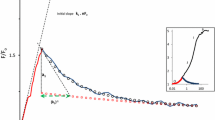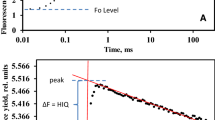Abstract
Plants respond to excess light by a photoprotective reduction of the light harvesting efficiency. The notion that the non-photochemical quenching of chlorophyll fluorescence can be reliably used as an indicator of the photoprotection is put to a test here. The technique of the repetitive flash fluorescence induction is employed to measure in parallel the non-photochemical quenching of the maximum fluorescence and the functional cross-section (σPS II) which is a product of the photosystem II optical cross-section aPS II and of its photochemical yield ΦPS II (σ PS II = aPS II ΦPS II). The quenching is measured for both, the maximum fluorescence found in a single-turnover flash (FM ST) and in a multiple turnover light pulse (FM MT). The experiment with the diatom Phaeodactylum tricornutum confirmed that, in line with the prevalent model, the PS II functional cross-section σ PS II is reduced in high light and restored in the dark with kinetics and amplitude that are closely matching the changes of the FM ST and FM MT quenching. In contrast, a poor correlation between the light-induced changes in the PS II functional cross-section σ PS II and the quenching of the multiple-turnover FM MT fluorescence was found in the green alga Scenedesmus quadricauda. The non-photochemical quenching in Scenedesmus quadricauda was further investigated using series of single-turnover flashes given with different frequencies. Several mechanisms that modulate the fluorescence emission in parallel to the QA redox state and to the membrane energization were resolved and classified in relation to the light harvesting capacity of Photosystem II.
Similar content being viewed by others
References
Arsalane W, Rousseau B and Duval J-C (1994) Influence of the pool size of the xanthophyll cycle on the effects of light stress in a diatom: Competition between photoprotection and photoinhibition. Photochem Photobiol 60: 237–243
Bilger W and Schreiber U (1986) Energy-dependent quenching of dark-level chlorophyll fluorescence in intact leaves. Photosynth Res 10: 303–308
Breton J, Geacintov NE and Swenberg CE (1979) Quenching of fluorescence by triplet excited states in chloroplasts. Biochim Biophys Acta 548: 616–635
Bruce D, Samson G and Carpenter C (1997) The origins of non-photochemical quenching of chlorophyll fluorescence in photosynthesis. Direct quenching by P680+ in Photosystem II enriched membranes at low pH. Biochemistry 36: 749–755
Butler WL (1978) Energy distribution in the photochemical apparatus of photosynthesis. Annu Rev Plant Physiol 29: 345–378
Christen G, Reifarth F and Renger G (1998) On the origin of the ′35-μs kinetics' of P680+• reduction in Photosystem II with an intact water oxidising complex. FEBS Lett 429: 49–52
Chylla RA and Whitmarsh J (1989) Inactive Photosystem II coplexes in leaves. Turnover rate and quantification. Plant Physiol 90: 765–772
Dau H (1994) Short-term adaptation of plants to changing light intensities and its relation to Photosystem II photochemistry and fluorescence emission. J Photochem Photobiol B 26: 3–27
Delosme R (1967) Etude de l'induction de fluorescence des algues vertes et des chloroplastes au début d'une illumination intense. Biochim Biophys Acta 143: 108–128
Delosme R (1971) New results about chlorophyll fluorescence ‘in vivo’. In: Forti G and Melandri A(eds) Proceedings of 2nd International Congress on Photosynthesis, Stresa, pp 187–195. W Junk Publishers, The Hague
Duysens LNM and Sweers HE (1963) Mechanism of the two photochemical reactions in algae as studied by means of fluorescence. In: Japanese Society of Plant Physiologists (eds) Studies on Microalgae and Photosynthetic Bacteria, pp 353–372. University of Tokyo Press, Tokyo
France LL, Geacintov NE, Breton J and Valkunas L (1992) The dependence of the degrees of sigmoidicities of fluorescence induction curve in spinach chloroplasts on the duration of actinic pulses in pump-probe experiments. Biochim Biophys Acta 1101: 105–119
Gorbunov MY, Kolber ZS and Falkowski PG (1999) Measuring photosynthetic parameters in individual algal cells by Fast Repetition Rate fluorometry. Photosynth Res 62: 141–153
Gorbunov MY, Falkowski PG and Kolber ZS (2000) Measurement of photosynthetic parameters in benthic organisms in situ using a SCUBA-based fast repetition rate fluorometer. Limnol Oceanogr 45: 242–245
Holzwarth AR (1995) Data analysis of time-resolved measurements. In Amesz J and Hoff AJ (eds) Biophysical Techniques in Photosynthesis, pp 75–92. Kluwer Academic Publishers, Dordrecht, The Netherlands
Horton P and Ruban AV (1992) Regulation of Photosystem II. Photosynth Res 34: 375–385
Horton P, Ruban AV and Walters RG (1994) Regulation of light harvesting in green plants. Indication by nonphotochemical quenching of chlorophyll fluorescence. Plant Physiol 106: 415–420
Joliot A and Joliot P (1964) Etudes cinétique de la réaction photochimique libérant l'oxygène au cours de la photosynthèse. CR Acad Sci Paris 258: 4622–4625
Joliot P and Joliot A (1971) Studies on the quenching properties of the photosystem II electron acceptor. In: Forti G and Melandri A (eds) Proceedings of the 2nd International Congress on Photosynthesis, pp 187–195. W Junk Publishers, The Hague
Joliot P, Barbieri B and Chabaud R (1969) Un Noveau Modèle des Centres Photochimiques du Système II. Photochem Photobiol 10: 309–329
Joliot P, Joliot A, Bouges B and Barbieri B (1971) Studies of Photosystem II photocenters by comparative measurements of luminescence, fluorescence and oxygen emission. Photochem Photobiol 14: 287–305
Jursinic P (1981) Investigation of double turnovers in Photosystem II charge separation and oxygen evolution with excitation flashes of different duration. Biochim Biophys Acta 635: 38–52
Koblížek M, Ciscato M, Komenda J, Kopecký J, Šiffel P and Masojídek J (1999) Photoadaptation in the green alga Spongiochloris sp. A three-fluorometer study. Photosynthetica 37: 307–323
Kok B, Forbush B and McGloin M (1970) Co-operation of charges in photosynthetic O2 evolution. I. A linear four step mechanism. Photochem Photobiol 11: 457–475
Kolber Z and Falkowski PG (1993) Use of active fluorescence to estimate phytoplankton photosynthesis In situ. Limnol Oceanogr 38: 1646–1665
Kolber Z, Prášil O and Falkowski P (1998) Measurements of variable chlorophyll fluorescence using fast repetition rate technique. I. Defining methodology and experimental protocols. Biochim Biophys Acta 1367: 88–106
Kramer DM, Robinson HR and Crofts AR (1990) A portable multi-flash kinetic fluorometer for measurements of donor and acceptor reactions of Photosystem 2 in leaves of intact plants under field conditions. Photosyth Res 26: 181–193
Kramer DM, Di Marco G and Loreto F (1995) Contribution of plastoquinone quenching to saturation pulse-induced rise of chlorophyll fluorescence in leaves In: Mathis P (ed) Photosynthesis: From Light to Biosphere, Vol I, pp 147–150. Kluwer Academic Publishers, Dordrecht, The Netherlands
Krause GH, Vernotte C and Briantais J-M (1982) Photoinduced quenching of chlorophyll fluorescence in intact chloroplasts and algae. Biochim Biophys Acta 679: 116–124
Lavergne J and Trissl H-W (1995) Theory of fluorescence induction in Photosystem II: Derivation of analytical expressions in a model including exciton-radical-pair equilibrium and restric152 ted energy transfer between photosynthetic units. Biophys J 68: 2474–2492
Lavorel J (1959) Induction of fluorescence in quinone poisoned Chlorella cells. Plant Phys 34: 204–209
Lazár D (1999) Chlorophyll a fluorescence induction. Biochim Biophys Acta 1412: 1–28
Malkin S and Kok B (1966) Fluorescence induction studies in isolated chloroplasts. I. Number of components involved in the reaction and quantum yields. Biochim Biophys Acta 126: 413–432
Masojídek J, Torzillo G, Koblížek M, Kopecký J, Bernardini P, Sacchi A and Komenda J (1999) Photoadaptation of two Chlorophyta (Scenedesmus and Chlorella) in laboratory and outdoor cultures: Changes of chlorophyll fluorescence quenching and the xanthophyll cycle. Planta 209: 126–135
Mauzerall D (1972) Light-induced fluorescence changes in Chlorella, and the primary photoreactions for the production of oxygen. Proc Natl Acad Sci USA 69: 1358–1362
Mullineaux C and Allen JF (1986) The state 2 transition in the cyanobacterium Synechococcus 6301 can be driven by respiratory electron flow into the plastoquinone pool. Biochim Biophys Acta 205: 155–160
Munday JCM and Govindjee (1969) Light-induced changes in the fluorescence yield of chlorophyll a in vivo. III. The dip and the peak on the fluorescence transient of Chlorella pyrenoidosa. Biophys J 9: 1–21
Nedbal L, Trtílek M and Kaftan D (1999) Flash Fluorescence Induction: A novel method to study regulation of Photosystem II. J Photochem Photobiol B 48: 154–157
Olaizola M, La Roche J, Kolber Z and Falkowski PG (1994) Nonphotochemical fluorescence quenching and the diadinoxanthin cycle in marine diatom. Photosynt Res 41: 357–370
Reifarth F, Christen G and Renger G (1997) Fluorometric equipment for monitoring P680+• reduction in PS II preparations and green leaves. Photosynth Res 51: 231–242
Samson G and Bruce D (1996) Origins of the low yield of chlorophyll a fluorescence induced by single turnover flash in spinach thylakoids. Biochim Biophys Acta 1276: 147–153
Samson G, Prášil O and Yaakoubd B (1999) Photochemical and thermal phases of chlorophyll a fluorescence. Photosynthetica 37: 163–182
Schreiber U and Krieger A (1996) Two fundamentally different types of variable chlorophyll fluorescence in vivo. FEBS Lett 397: 131–135
Schreiber U and Neubauer C (1987) The polyphasic rise of chlorophyll fluorescence upon onset of strong continuous illumination. II. Partial control by the photosystem II donor side and possible ways of interpretation. Z Naturforsch 42c: 1255–1264
Schreiber U, Schliwa U and Bilger W (1986) Continuous recording of photochemical and non-photochemical chlorophyll fluorescence quenching with a new type of modulation fluorometer. Photosynth Res 10: 51–62
Schweitzer RH and Brudvig GW(1997) Fluorescence quenching by chlorophyll cations in Photosystem II. Biochemistry 36: 11351–11359
Šetlík I, Šetlíková E, Masojídek J, Zachleder V, Kalina T and Mader P (1981) The effect of translantion and transcription inhibitors on the development of the photosynthetic apparatus in cell cycles of Scenedesmus quadricauda. In: Akoyunoglou G (ed) Photosynthesis Vol V. Chloroplast Development, pp 481–490. Balaban International Science Services, Philadelphia
Shinkarev VP, Xu C, Govindjee and Wraight CA (1997) Kinetics of the oxygen evolution step in plants determined from flashinduced chlorophyll a fluorescence. Photosynth Res 51: 43–49
Sorokin EM (1985) The induction curve of chlorophyll a fluorescence in DCMU-treated chloroplasts and its properties. Photochem Photobiol 9: 3–19
Strasser RJ (1981) The grouping model of plant photosynthesis: Heterogeneity of photosynthetic units in thylakoids. In: Akoyunoglou G (ed) Photosynthesis III. Structure and Molecular Organisation of the Photosynthetic Apparatus, pp 727–737. Balaban International Science Services Philadelphia
Strasser RJ, Srivastava A and Govindjee (1995) Polyphasic chlorophyll a fluorescence transient in plants and cyanobacteria. Photochem Photobiol 61: 32–42
Trtílek M, Kramer DM, Koblížek M and Nedbal L (1997) Dualmodulation LED kinetic fluorometer. J Luminesc 72–74: 597–599
Valkunas L, Geacintov NE, France L and Breton J (1991) The dependence of shapes of fluorescence induction curves in chloroplasts on the duration of illumination pulses. Biophys J 59: 397–408
Vasil'ev S and Bruce D (1998) Nonphotochemical quenching of excitation energy in Photosystem II. A picosecond time-resolved study of the low yield of chlorophyll a fluorescence induced by single-turnover flash in isolated spinach thylakoids. Biochemistry 37: 11046–1105
Zankel KL (1973) Rapid fluorescence changes observed in chloroplasts: Their relationship to the O2 evolving system. Biochim Biophys Acta 325: 138–148
Author information
Authors and Affiliations
Corresponding author
Rights and permissions
About this article
Cite this article
Koblížek, M., Kaftan, D. & Nedbal, L. On the relationship between the non-photochemical quenching of the chlorophyll fluorescence and the Photosystem II light harvesting efficiency. A repetitive flash fluorescence induction study. Photosynthesis Research 68, 141–152 (2001). https://doi.org/10.1023/A:1011830015167
Issue Date:
DOI: https://doi.org/10.1023/A:1011830015167




